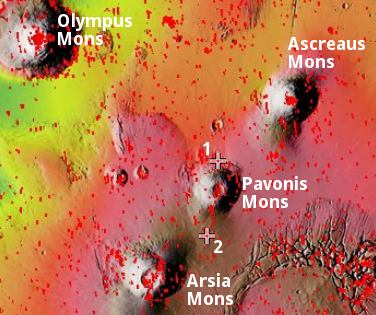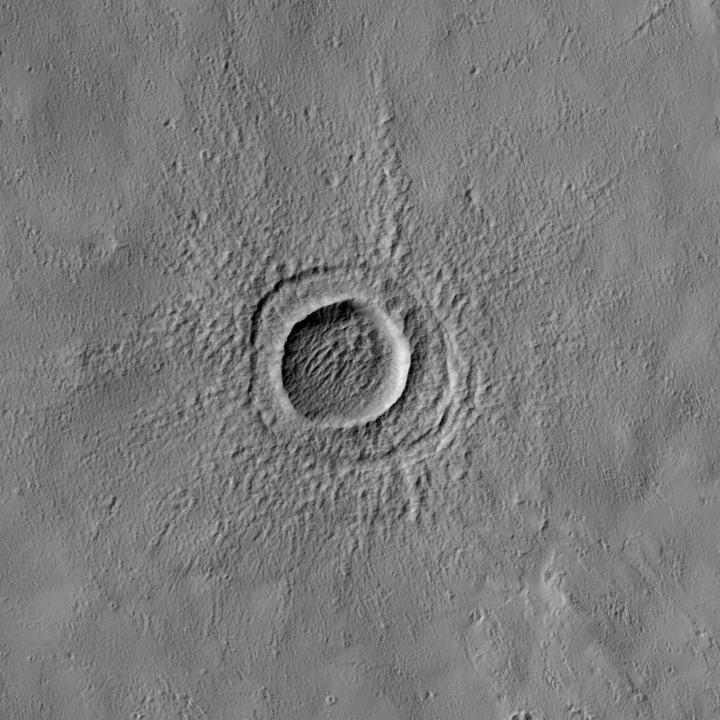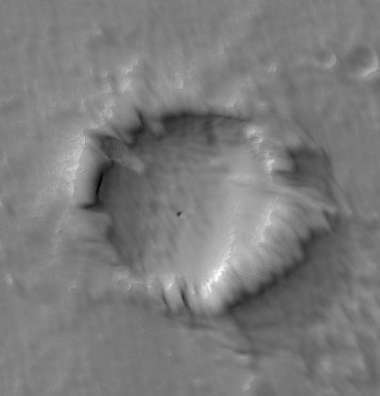Martian craters go splat!

Cool image time! In continuing my exploration of this month’s Mars Reconnaissance Orbiter (MRO) image release, I found two interesting images of small craters, one as part of that image release, the other found completely by accident.
The map on the right, taken from the MRO HiRISE archive page, shows the locations of these two images. Both are located in the lava plains that surround the giant volcano Pavonis Mons, the central volcano of the three volcanoes to the east of Olympus Mons. Previously, I have done posts focusing specifically on both Pavonis Mons and Arsia Mons. Not only is the geology of these gigantic volcanoes fascinating, there is evidence that ancient glacial ice lurks in lava tubes on their slopes, making them potentially prime real estate for future explorers.
The first image, labeled #1 on the image above, was taken in January 2018 to get a better look at a small crater on the surrounding lava plains, and was part of the MRO March image release. I have cropped it to post here, focusing on the crater itself.
My first reaction on seeing the image was, “Did this impact not go splat when it hit?”

To my eye the impact appears to have not penetrated the lava plain very deeply. Instead, it appears to have pushed down an upper layer, causing that circular crack that surrounds the crater. Second, the impact appears to have caused some form of outwards flow in all directions, but it is unclear whether that flow was on the surface, or below the ground between that upper layer and the lower layer below. My imagination thinks two lava layers with an ice layer between. The bolide hits the top layer, pushes it down, and the ice layer is liquefied and forced to push out between the two lava layers, pushing the top layer up all around the crater.
As an amateur geologist, no one should take this theory very seriously. The geology here is very intriguing, nonetheless, especially because of the theory that there is leftover glacial ice buried on the slopes of these volcanoes. I wonder if there could also be an ice layer in the plains around the volcanoes themselves.

The second image, labeled #2 on the overview image above, I found totally by accident. The lat/long for the first image is 4.467° N 247.353° E. The webpage however does not specify north or south for the latitude, and in my first attempt to locate where the first image was using the HiRISE archive I went to 4.467° SOUTH 247.353° E. In doing so I found an image in the southern lava plains of Pavonis Mons that showed a crater that was even stranger. I have cropped the main image to focus on that crater, posting it on the right.
This crater also looks like it went splat when the impactor hit, but unlike the first crater above this one seems to have landed in what looks like soft terrain, that has since experienced a great deal of erosion and change. Dust appears to significantly filled the crater floor, and that same blowing dust appears to have eroded and reshaped the crater’s entire rim, pushing everything to the southeast.
I should add that if you go to the HiRISE archive and explore the other images in this same region, you will see many similar craters, all with a strange soft look that appears to have been reshaped heavily by wind. Some look far stranger than this. For example, there are the craters/depressions on this image and the craters found on this image.
All look like a giant was brushing the dust to the southwest, smearing the crater rims and all jagged features. Very strange.
Of course, the strangeness here should not surprise us. Mars is not the Earth. The gravity is different, it’s history is different, its climate has never been similar, and it has changed far more radically over time that Earth’s ever did. Its alien nature however is a gift. It will, over centuries, teach us that we can make no assumptions about formation processes on other worlds. They may have some parallels to Earth, but those parallels will often be a stretch, and will often fool us in trying to figure out the origins of these alien formations.
To truly understand what happened here, we will be forced to think, and to think deeply, clearly, and objectively. It will be a good thing.
On Christmas Eve 1968 three Americans became the first humans to visit another world. What they did to celebrate was unexpected and profound, and will be remembered throughout all human history. Genesis: the Story of Apollo 8, Robert Zimmerman's classic history of humanity's first journey to another world, tells that story, and it is now available as both an ebook and an audiobook, both with a foreword by Valerie Anders and a new introduction by Robert Zimmerman.
The print edition can be purchased at Amazon or from any other book seller. If you want an autographed copy the price is $60 for the hardback and $45 for the paperback, plus $8 shipping for each. Go here for purchasing details. The ebook is available everywhere for $5.99 (before discount) at amazon, or direct from my ebook publisher, ebookit. If you buy it from ebookit you don't support the big tech companies and the author gets a bigger cut much sooner.
The audiobook is also available at all these vendors, and is also free with a 30-day trial membership to Audible.
"Not simply about one mission, [Genesis] is also the history of America's quest for the moon... Zimmerman has done a masterful job of tying disparate events together into a solid account of one of America's greatest human triumphs."--San Antonio Express-News


Lava on top of ice? That would make explosive steam… Ash deposits, maybe.
Good video simulations of crater formation. On Earth and the Moon. https://www.lpi.usra.edu/exploration/training/resources/impact_cratering/ Cratering on Mars would be somewhere between the two.
The speed at which a 50+ mile wide crater forms is staggering to imagine. All said and done in just a few minutes!
#1 looks like it has “normal” ejecta to me. The rim walls subsided. I’d be interested in knowing the diameter of it. Bigger than simple but not quite complex…?
BSJ: The ice layer would have arrived later, filling in gaps.